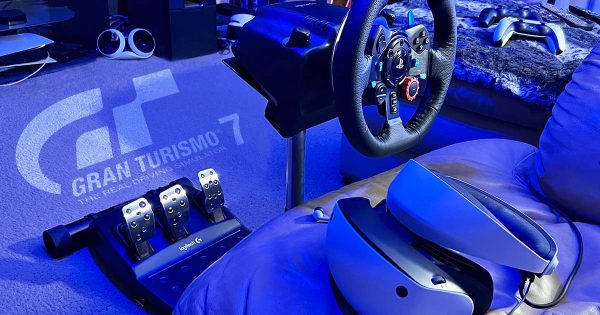
When PlayStation VR2 launched, I dabbled in Horizon Call of the Mountain because it was a great showcase for the tech advancements since the original headset. Eye tracking, resolution, foveated rendering, yadda. But in the year since firing up Gran Turismo 7, I played virtually nothing else while newer games keep arriving. Twenty-five thousand miles of white knuckles, meanwhile my real-life car (also rendered precisely in the game) has only 15,000 in five years. Sheer coincidence, the feature film announced soon after, which added to the excitement.
VR can be fatiguing, so I limit most gaming sessions to 30 minutes … but not GT7. Maybe it’s the simple controls: steer, gas, brake, paddles—all while seated. It’s also the only game that’s ever inspired me to invest in accessories, namely a racing wheel and adjustable stand (which someday will make a storied addition to my tech-museum closet). I continue to be amazed how unique and authentic they’re able to make each car feel with a combination of wheel resistance, sound, height, space, and of course physics. Being able to turn your head and check that blind spot is a huge advantage. It also makes for some shiny distractions when trying to capture environmental gameplay details like the tracks and weather and lighting. (Seriously, check out the way the cabin interior blooms when headlights hit your rearview.)
Once I realized I’d have to sell everything in my virtual garage to afford certain rare cars that unlock game progress, I started recording races of them first: the VR headset output followed by a replay switching angles in real time. I edited that footage into 30-second scenes per car showcasing their performance, uploading ten volumes of highlights in order of acquisition. Now 521 cars later, I reorganized those scenes into three videos embedded below. We’ll begin with all of the real-world road and race cars, grouped by country/maker/model/year, with chapter markers for easy navigation. Crank up the sound and get your pulse revving!
Many fictional cars are created specifically for the game. Some are modified production cars to meet racing-group standards. These are the least-interesting to me because I don’t race online, and their similar specs—like NASCAR—don’t allow for domination (which I guess just made me work harder to give you a good race!). Other concept cars are known as Vision Gran Turismo (VGT), designed by actual manufacturer teams previewing their racing futures. They’re the fastest in the game, some outperforming my own human reflexes. 250+ MPH is terrifying in VR! I’m looking at you, Dodge Tomahawk.
I’m not a gearhead—my car obsession is more like a kid’s Hot Wheels collection—so I don’t really get into tuning. But I loved swapping these 52 high-performance engines into lesser cars. It’s way more thrilling to dust a Lamborghini in some old VW you can barely keep on the track … much less avoid collisions. Each engine is compatible with up to ten other bodies. I added fun sponsor liveries to distinguish them from their originals, but no body upgrades to handle the extreme horsepower. I’m not endurance racing, so embrace the brief chaos.
Below are playlists containing my unedited races just as captured, in the same order as above, except the engines, which are listed by swapped car body instead. Choose a video from the pop-up menu at its top right (visit YouTube for the complete list).
My Favorite Cars to Drive in Gran Turismo
1) 2001 BMW Z8
2) 2013 Porsche 918 Spyder
3) 2013 Bugatti Veyron
4) 1984 Ferrari GTO
5) 2002 Mazda RX-7 Spirit R Type A
6) 2016 Aston Martin DB11
7) 1996 Suzuki V6 Escudo Pikes Peak Special
8) 1980 Maserati Merak SS
9) Red Bull X2014 Standard
10) McLaren Ultimate VGT
This post has been edited several times to update progress with more cars.









